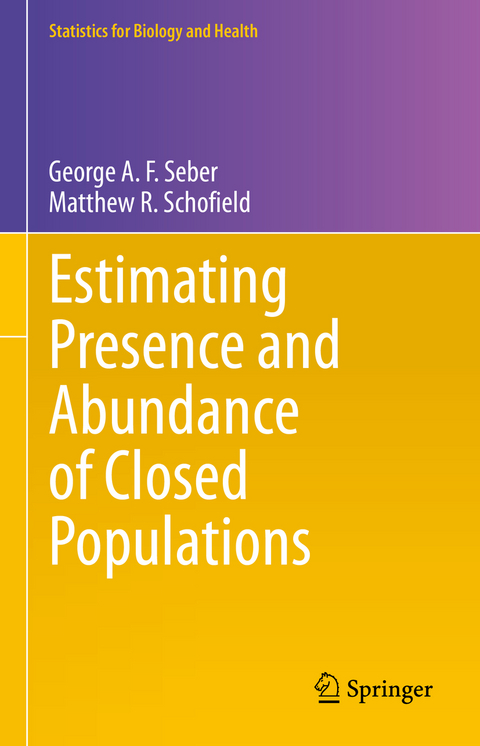
Estimating Presence and Abundance of Closed Populations
Springer International Publishing (Verlag)
9783031398339 (ISBN)
This comprehensive book covers a wide variety of methods for estimating the sizes and related parameters of closed populations. With the effect of climate change, and human territory invasion, we have seen huge species losses and a major biodiversity decline. Populations include plants, trees, various land and sea animals, and some human populations. With such a diversity of populations, an extensive variety of different methods are described with the collection of different types of data. For example, we have count data from plot sampling, which can also allow for incomplete detection. There is a large chapter on occupancy methods where a major interest is determining whether a particular species is present or not. Citizen and opportunistic survey data can also be incorporated. A related topic is species methods, where species richness and species' interactions are of interest.
A variety of distance methods are discussed. One can use distances from points and lines, as wellas nearest neighbor distances. The applications are extensive, and include marine, acoustic, and aerial surveys, using multiple observers or detection devices. Line intercept measurements have a role to play such as, for example, estimating parameters relating to plant coverage.
An increasingly important class of removal methods considers successive "removals" from a population, with physical removal or "removal" by capture-recapture of marked individuals. With the change-in-ratio method, removals are taken from two or more classes, e.g., males and females. Effort data used for removals can also be used.
A very important method for estimating abundance is the use of capture-recapture data collected discretely or continuously and can be analysed using both frequency and Bayesian methods. Computational aspects of fitting Bayesian models are described. A related topic of growing interest is the use of spatial and camera methods.
With the plethora of models there has been a corresponding development of various computational methods and packages, which are often mentioned throughout. Covariate data is being used more frequently, which can reduce the number of unknown parameters by using logistic and loglinear models. An important computational aspect is that of model selection methods. The book provides a useful list of over 1400 references.
lt;p>George Seber is a retired Professor of Statistics at Auckland University, New Zealand, a Fellow of the Royal Society of New Zealand, and recipient of the Society's Hector Medal in Information Sciences. He is the author or co-author of eighteen books on various branches of statistics. More recently, as a counsellor/psychotherapist with a 20-year practice, he has written an extensive book on counselling for practitioners, books on the topics of dying and death of loved ones, sleep, and alcohol, as well as a book on religion and science. He has published numerous research articles on a variety of statistical subjects.
Matthew Schofield is an Associate Professor of Statistics at the University of Otago, New Zealand. He is a recipient of the Littlejohn Research Award, the premier research award of the New Zealand Statistical Association. He has published over forty research articles, many of which involve the development of capture-recapture methodology.
1 Model building.- 2 Plot sampling.- 3 Detectability.- 4 Occupancy, Abundance and Related Topics.- 5 Species Methods.- 6 Closest distance and nearest neighbor methods.- 7 Point Counts and Point-Distance Methods.- 8 Line Transect and Distance Methods.- 9 Line Intercept Methods.- 10 Removal and Change-in-Ratio Methods.- 11 Catch-effort models.- 12 Capture-Recapture: Frequentist Methods.- 13 Capture-Recapture: Bayesian Methods-. 14 Spatial and Camera Methods.- A Some General Results.- References.- Index.
| Erscheinungsdatum | 02.12.2023 |
|---|---|
| Reihe/Serie | Statistics for Biology and Health |
| Zusatzinfo | XIX, 723 p. 3 illus. |
| Verlagsort | Cham |
| Sprache | englisch |
| Maße | 155 x 235 mm |
| Gewicht | 1274 g |
| Themenwelt | Mathematik / Informatik ► Mathematik ► Statistik |
| Mathematik / Informatik ► Mathematik ► Wahrscheinlichkeit / Kombinatorik | |
| Naturwissenschaften ► Biologie ► Ökologie / Naturschutz | |
| Schlagworte | acoustic, and aerial surveys • Animal Migration • bayesian models • capture-recapture • capture-recapture methods • catch-effort • detectability • distance methods • line-intercept models • Marine • Occupancy • Plot sampling • point and line transects • removal and CIR methods • Spatial Methods • species methods • State-space Models • Survival estimation |
| ISBN-13 | 9783031398339 / 9783031398339 |
| Zustand | Neuware |
| Informationen gemäß Produktsicherheitsverordnung (GPSR) | |
| Haben Sie eine Frage zum Produkt? |
aus dem Bereich


